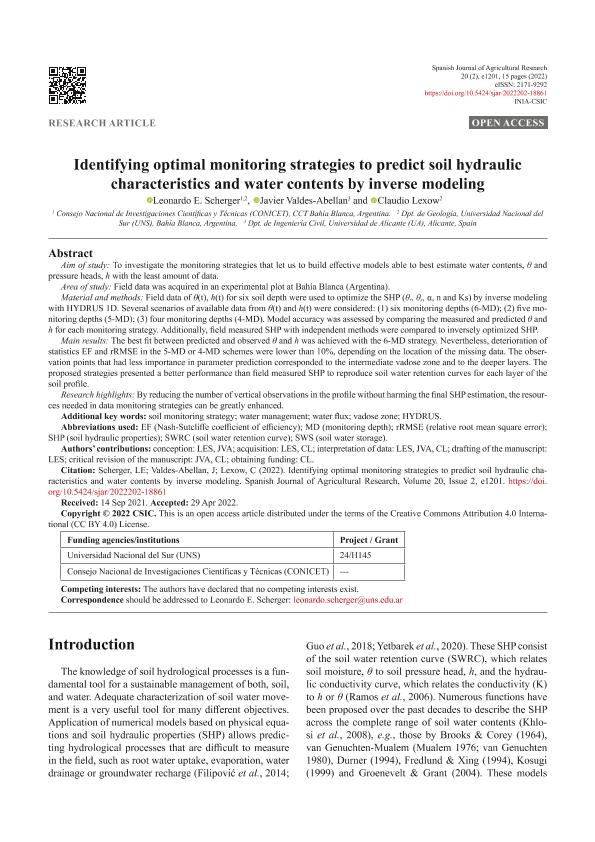Mostrar el registro sencillo del ítem
dc.contributor.author
Scherger, Leonardo Ezequiel

dc.contributor.author
Valdes Avellan Javier
dc.contributor.author
Lexow, Claudio

dc.date.available
2023-10-24T17:45:42Z
dc.date.issued
2022-07
dc.identifier.citation
Scherger, Leonardo Ezequiel; Valdes Avellan Javier; Lexow, Claudio; Identifying optimal monitoring strategies to predict soil hydraulic characteristics and water contents by inverse modeling; Spanish National Institute for Agriculture and Food Research and Technology; Spanish Journal Of Agricultural Research; 20; 2; 7-2022; 1-15
dc.identifier.issn
1695-971X
dc.identifier.uri
http://hdl.handle.net/11336/215783
dc.description.abstract
Aim of study: To investigate the monitoring strategies that let us to build effective models able to best estimate water contents, θ and pressure heads, h with the least amount of data. Area of study: Field data was acquired in an experimental plot at Bahía Blanca (Argentina). Material and methods: Field data of θ(t), h(t) for six soil depth were used to optimize the SHP (θr, θs, α, n and Ks) by inverse modeling with HYDRUS 1D. Several scenarios of available data from θ(t) and h(t) were considered: (1) six monitoring depths (6-MD); (2) five monitoring depths (5-MD); (3) four monitoring depths (4-MD). Model accuracy was assessed by comparing the measured and predicted θ and h for each monitoring strategy. Additionally, field measured SHP with independent methods were compared to inversely optimized SHP. Main results: The best fit between predicted and observed θ and h was achieved with the 6-MD strategy. Nevertheless, deterioration of statistics EF and rRMSE in the 5-MD or 4-MD schemes were lower than 10%, depending on the location of the missing data. The observation points that had less importance in parameter prediction corresponded to the intermediate vadose zone and to the deeper layers. The proposed strategies presented a better performance than field measured SHP to reproduce soil water retention curves for each layer of the soil profile. Research highlights: By reducing the number of vertical observations in the profile without harming the final SHP estimation, the resources needed in data monitoring strategies can be greatly enhanced.
dc.format
application/pdf
dc.language.iso
eng
dc.publisher
Spanish National Institute for Agriculture and Food Research and Technology

dc.rights
info:eu-repo/semantics/openAccess
dc.rights.uri
https://creativecommons.org/licenses/by/2.5/ar/
dc.subject
HYDRUS
dc.subject
SOIL MONITORING STRATEGY
dc.subject
VADOSE ZONE
dc.subject
WATER FLUX
dc.subject
WATER MANAGEMENT
dc.subject.classification
Oceanografía, Hidrología, Recursos Hídricos

dc.subject.classification
Ciencias de la Tierra y relacionadas con el Medio Ambiente

dc.subject.classification
CIENCIAS NATURALES Y EXACTAS

dc.title
Identifying optimal monitoring strategies to predict soil hydraulic characteristics and water contents by inverse modeling
dc.type
info:eu-repo/semantics/article
dc.type
info:ar-repo/semantics/artículo
dc.type
info:eu-repo/semantics/publishedVersion
dc.date.updated
2023-10-23T16:58:43Z
dc.journal.volume
20
dc.journal.number
2
dc.journal.pagination
1-15
dc.journal.pais
España

dc.journal.ciudad
Madrid
dc.description.fil
Fil: Scherger, Leonardo Ezequiel. Universidad Nacional del Sur. Departamento de Geología; Argentina. Consejo Nacional de Investigaciones Científicas y Técnicas. Centro Científico Tecnológico Conicet - Bahía Blanca; Argentina
dc.description.fil
Fil: Valdes Avellan Javier. Universidad de Alicante; España
dc.description.fil
Fil: Lexow, Claudio. Universidad Nacional del Sur. Departamento de Geología; Argentina
dc.journal.title
Spanish Journal Of Agricultural Research

dc.relation.alternativeid
info:eu-repo/semantics/altIdentifier/url/https://revistas.inia.es/index.php/sjar/article/view/18861
dc.relation.alternativeid
info:eu-repo/semantics/altIdentifier/doi/http://dx.doi.org/10.5424/sjar/2022202-18861
Archivos asociados
